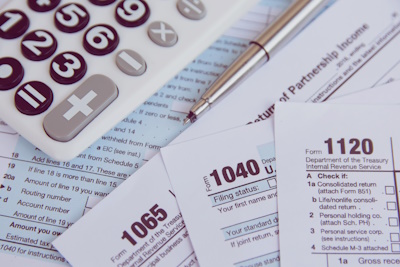Este artículo estará disponible en español en El Tiempo Latino.
On the day of the tax filing deadline, former President Donald Trump went on Truth Social to misleadingly warn that if President Joe Biden is reelected, “you will soon be facing colossal tax HIKES.” But in his latest budget proposal, Biden supports extending the tax cuts championed by Trump for people making less than $400,000.

“Happy TAX DAY to everyone,” Trump wrote on April 15, the last day for most people to file their federal tax returns. “This year, the typical family’s tax bill is thousands of dollars lower because of the Trump Tax Cuts. We doubled your Standard Deduction. We doubled the child tax cuts—and we lowered income tax rates for EVERYONE. But if Crooked Joe Biden gets his way, you will soon be facing colossal tax HIKES…”
He’s talking about the 2017 Tax Cuts and Jobs Act, which became effective in 2018. Whether it reduced the “typical family’s” tax bill by “thousands” depends on how one defines the typical family. According to a Tax Policy Center analysis, the law reduced the individual income taxes owed by Americans by about $1,260 on average in 2018. Taxpayers in the middle 20% of earners (those with income between about $49,000 and $86,000) saw an average tax cut of about $800.
Only those in the top quintile of earners — those making over $149,400 — saw average tax savings in the “thousands” ($5,790 on average).
And while it’s true that tax rates were cut for nearly “EVERYONE,” not everyone got a tax cut as a result of the TCJA. The nonpartisan Tax Policy Center estimated that about 65% of taxpayers got a tax cut, while about 6% saw a tax increase.
As for Trump’s warning that if Biden “gets his way, you will soon be facing colossal tax HIKES,” Trump has been making that misleading claim for years. Yet, in his three years as president, Biden’s major tax changes have included setting a minimum corporate tax rate and lowering taxes for some families by expanding the child tax credit and making it fully refundable.
During the 2020 campaign, Trump falsely claimed that Biden’s tax plans would result in “doubling and tripling your taxes.” As we wrote then, while Biden proposed to raise an additional $4 trillion in taxes over the next decade, the increases would have fallen mainly on very high-income earners and corporations. The plan would not have doubled or tripled people’s taxes at any income level (on average), according to analyses of Biden’s plan by the Penn Wharton Budget Model, the Tax Policy Center and the Tax Foundation.
More recently, after winning New Hampshire’s GOP primary in January, Trump claimed Democrats “want to raise your taxes times four,” but the Tax Policy Center said Biden’s 2024 budget would, on average, increase after-tax incomes for low-income households and “leave them effectively unchanged for middle-income households.” The Tax Policy Center noted, “The top 1 percent, with at least roughly $1 million in income, would pay an average of $300,000 more than under current law, dropping their after-tax incomes by 14 percent.” That’s a sizable amount, but the top 1% wouldn’t be the “typical” American family.
In March, Biden released his fiscal year 2025 budget, which contains many of the same proposals and adds a few new wrinkles. But it still does not contain any “colossal tax hikes” on typical American families.

Biden’s latest plan proposes — as he has in the past — to increase the corporate income tax rate from 21% to 28%, and to restore the top individual tax rate of 39.6% from the current rate of 37%. It would also increase the corporate minimum tax rate to 21% for companies that report average profits in excess of $1 billion over a three-year period. (The 2022 Inflation Reduction Act established a minimum of 15%.) And the plan would impose a 25% minimum tax on very wealthy individuals. The plan also proposes to extend the expanded child tax credit enacted in the American Rescue Plan through 2025, and to make the child tax credit fully refundable on a permanent basis.
As he has since the 2020 campaign, Biden’s FY 2025 budget vows not to increase taxes on people earning less than $400,000.
In order to keep that pledge, Biden would have to extend most of the individual income tax provisions enacted in the TCJA that are set to expire at the end of 2025. And that’s what Biden says he would do — but only for individual filers earning less than $400,000 and married couples making less than $450,000.
The budget says Biden “[s]upports paying for extending tax cuts for people earning less than $400,000 with additional reforms to ensure that wealthy people and big corporations pay their fair share, so that the problematic sunsets created by President Trump and congressional Republicans are addressed in a fiscally responsible manner.” (In order to pass the TCJA with a simply majority, Republicans wrote the law to have most of the individual income tax changes expire after 2025.)
“Bottom line: Biden is promising to protect the TCJA tax cuts for at least 95 percent of households,” Howard Gleckman, a senior fellow at the Urban-Brookings Tax Policy Center, told us via email. “Whether he actually could deliver is another matter, but that is his promise.”
The Biden budget plan “would raise marginal income tax rates faced by higher earners and corporations while expanding tax credits for lower-income households,” according to a Tax Foundation analysis of the tax provisions in Biden’s budget. “The budget would redistribute income from high earners to low earners. The bottom 60 percent of earners would see increases in after-tax income in 2025, while the top 40 percent of earners would see decreases.”
In other words, if one considers the “typical American family” to be among the middle 20% of earners, those taxpayers would see a small increase in after-tax incomes in 2025 (0.5% on average) and a slight decrease (0.2%) by 2034, according to the Tax Foundation. The difference, explained Garrett Watson, senior policy analyst and modeling manager at the Tax Foundation, is largely due to the expiration of the expanded child tax credit after 2025. As we said, Biden has proposed extending the expanded child tax credit.
However, the pro-business Tax Foundation also wrote that because Biden’s plan would increase taxes on businesses and high-income people, the proposed changes would harm the economy in the long run, reducing the GDP by 2.2%, the capital stock by 3.8%, wages by 1.6%, and employment by about 788,000 jobs. Factoring in the economic effects of the lower long-run GDP, the Tax Foundation estimates middle-income earners would see their after-tax income reduced by about 2.1% in 10 years.
But as Watson explained in an email, the Tax Foundation’s estimates about lower after-tax incomes due to the impact on economic growth “are distinct from direct tax hikes, but they have similar effects to tax hikes in that the amount of income after-tax is lower from either source.”
A Washington Post analysis of Biden’s budget plan found it fails to say how it will pay for the proposal to extend tax cuts in the TCJA for those making under $400,000, calling into question whether Biden can keep that promise while also upholding his budget pledge to cut deficits by about $3 trillion over 10 years. (Trump, too, would have to find new revenue or cut spending to avoid higher deficits if the tax cuts are extended.)
And we should also note, as we often do when discussing a president’s budget plans, they are largely symbolic statements of priorities, not legislation on which Congress actually votes. Case in point: Biden’s budgets have included most of the large tax proposals this one does, and those proposals were never enacted even when Democrats held a majority in both the House (barely) and Senate in Biden’s first two years in office.
Of course, Biden did create a corporate minimum tax rate of 15% in 2022, and Trump was able to get his tax cut plan into law.
Still, whether Biden’s plan can be enacted or not, the president’s budget represents what Biden would do if he “gets his way,” as Trump put it, and that stated plan does not include “colossal tax hikes” for the “typical family.”
Editor’s note: FactCheck.org does not accept advertising. We rely on grants and individual donations from people like you. Please consider a donation. Credit card donations may be made through our “Donate” page. If you prefer to give by check, send to: FactCheck.org, Annenberg Public Policy Center, 202 S. 36th St., Philadelphia, PA 19104.